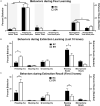Individual Differences in Conditioned Fear and Extinction in Female Rats
- PMID: 34489657
- PMCID: PMC8418198
- DOI: 10.3389/fnbeh.2021.740313
Individual Differences in Conditioned Fear and Extinction in Female Rats
Abstract
The inability to extinguish a traumatic memory is a key aspect of post-traumatic stress disorder (PTSD). While PTSD affects 10-20% of individuals who experience a trauma, women are particularly susceptible to developing the disorder. Despite this notable female vulnerability, few studies have investigated this particular resistance to fear extinction observed in females. Similar to humans, rodent models of Pavlovian fear learning and extinction show a wide range of individual differences in fear learning and extinction, although female rodents are considerably understudied. Therefore, the present study examined individual differences in fear responses, including freezing behavior and ultrasonic vocalizations (USVs), of female Long-Evans rats during acquisition of fear conditioning and cued fear extinction. Similar to prior studies in males, female rats displayed individual variation in freezing during cued fear extinction and were divided into extinction competent (EC) and extinction resistant (ER) phenotypes. Differences in freezing between ER and EC females were accompanied by shifts in rearing during extinction, but no darting was seen in any trial. Freezing behavior during fear learning did not differ between the EC and ER females. Vocalizations emitted in the 22 and 50 kHz ranges during fear learning and extinction were also examined. Unlike vocalizations seen in previous studies in males, very few 22 kHz distress vocalizations were emitted by female rats during fear acquisition and extinction, with no difference between ER and EC groups. Interestingly, all female rats produced significant levels of 50 kHz USVs, and EC females emitted significantly more 50 kHz USVs than ER rats. This difference in 50 kHz USVs was most apparent during initial exposure to the testing environment. These results suggest that like males, female rodents show individual differences in both freezing and USVs during fear extinction, although females appear to vocalize more in the 50 kHz range, especially during initial periods of exposure to the testing environment, and emit very few of the 22 kHz distress calls that are typically observed in males during fear learning or extinction paradigms. Overall, these findings show that female rodents display fear behavior repertoires divergent from males.
Keywords: fear extinction; females; freezing; individual differences; ultrasonic vocalization.
Copyright © 2021 Tryon, Sakamoto, Kellis, Kaigler and Wilson.
Conflict of interest statement
The authors declare that the research was conducted in the absence of any commercial or financial relationships that could be construed as a potential conflict of interest.
Figures





Similar articles
-
ChAT::Cre transgenic rats show sex-dependent altered fear behaviors, ultrasonic vocalizations and cholinergic marker expression.Genes Brain Behav. 2023 Feb;22(1):e12837. doi: 10.1111/gbb.12837. Epub 2023 Jan 13. Genes Brain Behav. 2023. PMID: 36636833 Free PMC article.
-
Sounding the Alarm: Sex Differences in Rat Ultrasonic Vocalizations during Pavlovian Fear Conditioning and Extinction.eNeuro. 2022 Dec 23;9(6):ENEURO.0382-22.2022. doi: 10.1523/ENEURO.0382-22.2022. Print 2022 Nov-Dec. eNeuro. 2022. PMID: 36443006 Free PMC article.
-
Sex differences in fear expression and persistence in an animal model of Post-Traumatic Stress Disorder.Neuroscience. 2024 Nov 12;560:371-380. doi: 10.1016/j.neuroscience.2024.09.045. Epub 2024 Oct 2. Neuroscience. 2024. PMID: 39366450
-
From Play to Aggression: High-Frequency 50-kHz Ultrasonic Vocalizations as Play and Appeasement Signals in Rats.Curr Top Behav Neurosci. 2017;30:91-108. doi: 10.1007/7854_2015_432. Curr Top Behav Neurosci. 2017. PMID: 26728173 Review.
-
The Melatonergic System in Anxiety Disorders and the Role of Melatonin in Conditional Fear.Vitam Horm. 2017;103:281-294. doi: 10.1016/bs.vh.2016.09.003. Epub 2016 Oct 31. Vitam Horm. 2017. PMID: 28061973 Review.
Cited by
-
Sex differences in fear responses: Neural circuits.Neuropharmacology. 2023 Jan 1;222:109298. doi: 10.1016/j.neuropharm.2022.109298. Epub 2022 Oct 31. Neuropharmacology. 2023. PMID: 36328063 Free PMC article. Review.
-
Differential modulation of freezing and 22-kHz USVs by shock intensity, tone-duration matching, and anxiety levels in rodent fear-conditioning paradigms.Learn Behav. 2025 Apr 9. doi: 10.3758/s13420-025-00671-6. Online ahead of print. Learn Behav. 2025. PMID: 40205078
-
ChAT::Cre transgenic rats show sex-dependent altered fear behaviors, ultrasonic vocalizations and cholinergic marker expression.Genes Brain Behav. 2023 Feb;22(1):e12837. doi: 10.1111/gbb.12837. Epub 2023 Jan 13. Genes Brain Behav. 2023. PMID: 36636833 Free PMC article.
-
Darting across space and time: parametric modulators of sex-biased conditioned fear responses.Learn Mem. 2022 Jun 16;29(7):171-180. doi: 10.1101/lm.053587.122. Print 2022 Jul. Learn Mem. 2022. PMID: 35710304 Free PMC article.
-
The elegant complexity of fear in non-human animals.Emerg Top Life Sci. 2022 Dec 9;6(5):445-455. doi: 10.1042/ETLS20220001. Emerg Top Life Sci. 2022. PMID: 36069657 Free PMC article.
References
Grants and funding
LinkOut - more resources
Full Text Sources

